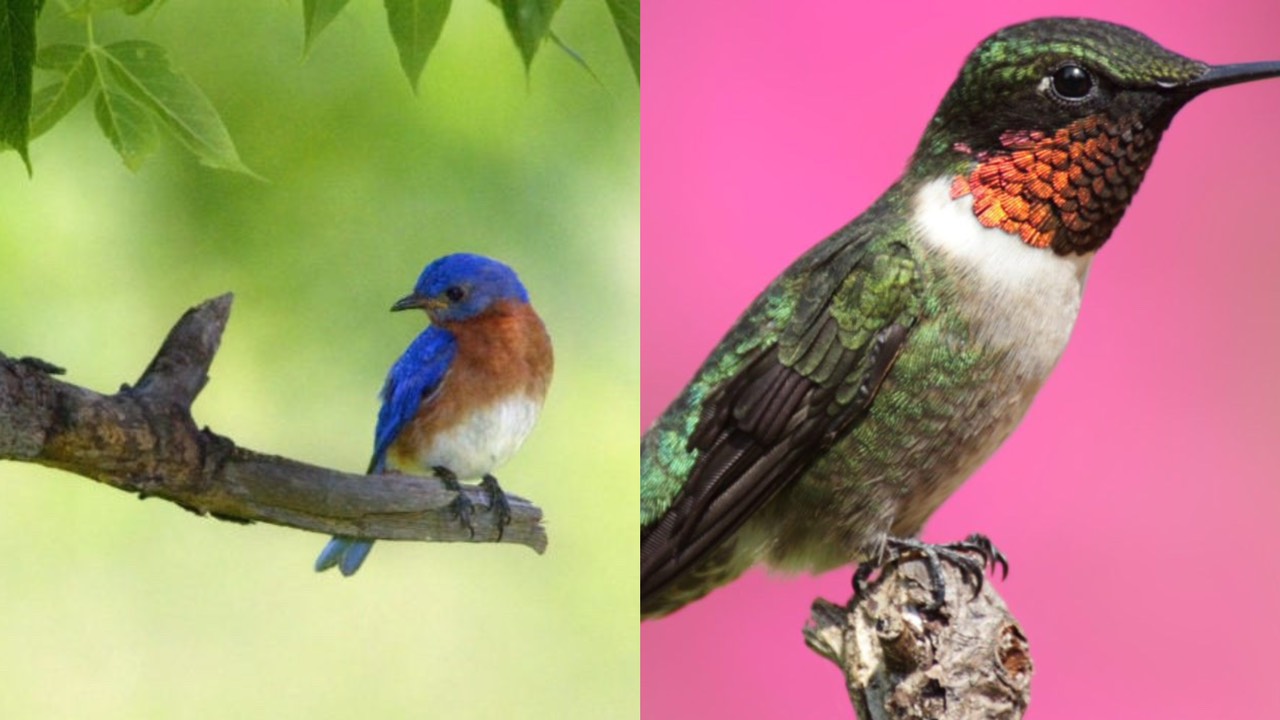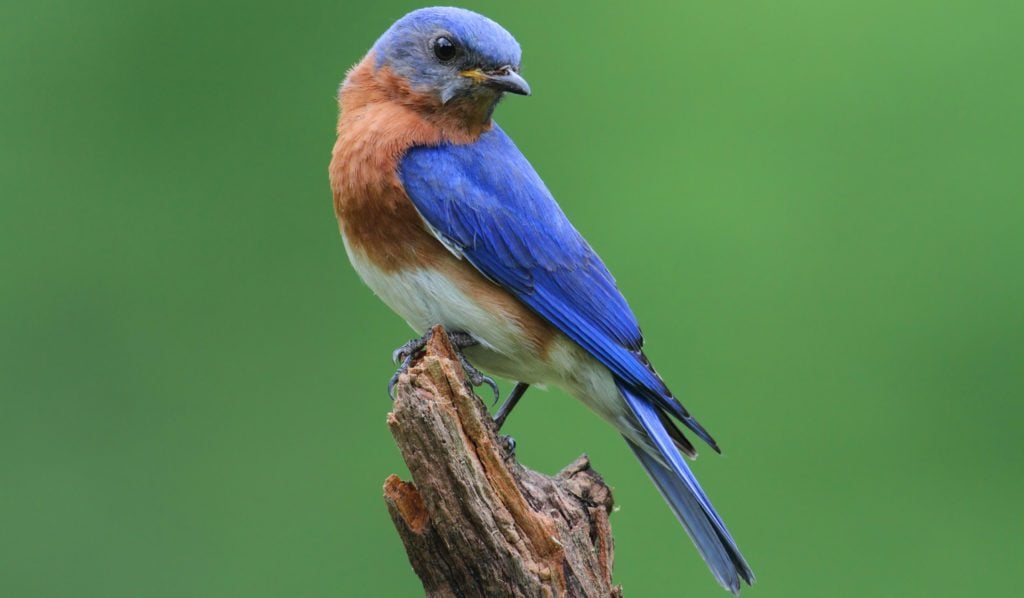
And seriously, why would you not want these beautiful birds in your backyard?

Personally, I think there is nothing more beautiful than seeing a bluebird in the snow. The incredible contrast of colors always stops me in my tracks to watch.
Today, I am providing 6 strategies that should help attract bluebirds to your yard!
-
Eastern Bluebird: Found east of the Rockies from southeastern Canada south to the Gulf of Mexico.
-
Mountain Bluebird: Breeds in southern Alaska, east to Manitoba, and south to western Nebraska to California. Spends winters throughout the western USA.
-
Western Bluebird: Found north to British Columbia and western Alberta and south into Mexico. Found east throughout the Rocky Mountains to eastern New Mexico.
#1. Provide Foods That Bluebirds Will Actually Eat.

Bluebirds will probably never visit a bird feeding station that ONLY serves typical feeder foods like sunflower, safflower, Nyjer (thistle), peanuts, etc.
This is because bluebirds naturally feed mostly on insects, snails, worms, and other invertebrates during the warmer months. In the winter, they switch their diet to berries until the bugs come back.
So I’m sure you can see the problem: Bluebirds don’t eat the typical birdseed buffet offered in most bird feeders because the foods don’t align with what they naturally eat.
But don’t worry; it’s possible to attract bluebirds to your bird feeding station without having to go digging around your garden for worms and bugs. There is an easy solution!
Enter the mealworm!

Mealworms are the larvae of the darkling beetle (So technically, they are not worms at all). They are easy to raise and commercially available as bird food, pet food, and fish bait.
And the good news is that bluebirds LOVE mealworms!
It may take a little patience and effort on your behalf, but the best way to attract bluebirds to your feeding station is by providing mealworms consistently.
There are two ways to purchase and use mealworms:
Live Mealworms: View Cost – Amazon
There is no doubt that bluebirds enjoy eating living mealworms the most. The bad news is that live mealworms are more expensive than freeze-dried and you must provide care to keep them alive.
Dried Mealworms: View Cost – Amazon
The best part about dried mealworms is they are less expensive and easier to store and handle than living ones. The negatives are that bluebirds sometimes won’t eat dried mealworms without some training!
If you are having issues getting your bluebirds to eat DRIED mealworms, try this strategy:

First, start with live mealworms. Once your bluebirds are consistently and eagerly eating these delicious treats, add in just a few dried mealworms. We are hoping they accidentally eat one of the dried options and realize it’s not so bad. Every day increase the number of dried mealworms and decrease the live ones.
Eventually, you will have trained the bluebirds only to eat dried mealworms! 🙂
Tip #2. Attract Bluebirds With These Feeders…

Now that we know that bluebirds are attracted to eating mealworms, we need to find bird feeders that specialize in feeding these delicious treats.
Below are THREE bird feeders that feed mealworms well. Specifically, they each have an edge or wall that prevents LIVE mealworms from crawling out!
A. Droll Yankees Domed Platform Feeder

View Cost – Amazon
This clear, domed, plastic feeder is one of my favorite bird feeders. It is incredibly versatile, and almost any food can be offered in its tray. If you choose to provide live mealworms, they won’t be able to climb the smooth lip of the dish.
I also love that the domed top is adjustable and can be lowered to keep out larger birds, such as grackles!
B. Stokes Snacks and Treats Feeder

This small bird feeder is perfect for offering a small number of mealworms in your backyard. I think it’s an excellent addition to a bird feeding station that already features lots of different feeders.
I’m also known to put other specialty foods inside, such as grapes, jelly, or suet nuggets, depending on the time of year and what birds I’m trying to attract.
C. Woodlink 3-in-1 Platform Bird Feeder

I LOVE this tray feeder and own a few of them! One is always sitting on the ground underneath my feeding station, and the other is hanging from my feeding pole.
To attract bluebirds, you should hang this feeder and fill it with mealworms. Live mealworms shouldn’t be able to climb out due to the high wooden wall. There is also a screen bottom, so water drains out quickly and keeps the food dry.
To see what feeders I am currently using, check out my LIVE webcam below!
Tip #3. Don’t Forget That Bluebirds Need To Drink
Believe it or not, most people never use birdbaths to attract bluebirds to their yards!
I think this is a mistake. From a bluebird’s perspective, it can be a bit intimidating to come to a bird feeder to eat foods they aren’t used to eating in nature (like mealworms)!
But a birdbath that offers freshwater serves two purposes. First, bluebirds need to drink every day to survive, so having a consistent water source is vital for their survival. Second, bluebirds like to take baths to clean themselves (and who doesn’t?).
So why don’t more backyard birders have birdbaths?
I think it’s because birdbaths require a bit of maintenance. The freshwater that you pour into your beautiful, new bath quickly becomes a pool of waste and dirt. And the more birds that use your birdbath, the worse the problem becomes.
I do a quick clean out of my bath and replace the gross water with fresh every other day. Then every few weeks I take a hose and scrub brush and do a thorough cleaning. Trust me, once you get in the habit, maintaining a birdbath is easy, and completely worth the effort to attract bluebirds!
Who knows, you may even see some exciting new animals (such as the below hawk!) come to your birdbath!
Lastly, make sure to keep the water heated in winter! 🙂
Tip #4. Make Your Backyard Habitat Bluebird-Friendly.
To help attract bluebirds, you need to create a habitat that these birds use in nature! The best way to do that is plant trees, shrubs, and flowers that appeal to them.
So what types of plants are best for attracting bluebirds?
Well, remember we learned earlier that bluebirds rely on two types of food for survival: bugs and berries. So if you want a chance at seeing bluebirds, make sure that your landscaping includes lots of plants that provide these two foods.

Plants That Attract and Provide Bugs:
When it comes to selecting plants to use in your backyard that provide bugs, there is only ONE requirement:
You must use NATIVE trees, shrubs, and flowers!
That’s because grasshoppers, crickets, beetles, and caterpillars, which are bluebirds’ favorite foods, are only attracted to plants native to North America.
This makes sense when you think about it; that beautiful shrub from China for sale at your local garden store may look pretty, but native insects and arthropods are not adapted to it and therefore won’t be attracted. And if bugs don’t like your plants, then birds that eat those bugs won’t be coming to your backyard!
If you DON’T WANT wildlife in your backyard, my #1 tip is to plant exotic plants from around the world!
To help find local plants that are native to your region, I have two recommendations:
Plants That Provide Berries For Bluebirds:

Bluebirds eat berries any time throughout the year, but they become an especially important part of their diet in winter.
That’s because there are no bugs to eat once the weather turns cold! Bluebirds HAVE to eat berries to survive.
In your backyard, my recommendation is to plant multiple types of native berry-producing plants. Make sure to select some plants that ripen during the summer months, along with varieties that have berries that ripen in late Fall, which will provide food for bluebirds through winter.
Here are a few more tips when creating your bluebird habitat:
A. Don’t Cut Down Dead Trees!
I know dead trees can be an eyesore, but rotting wood is where woodpeckers create cavities, which are the nesting sites that bluebirds will eventually use.
B. Don’t Trim Dead Limbs Off Trees!

Dead limbs are commonly trimmed off trees. These dead limbs may look terrible to a homeowner, but many birds use these old branches as perches. Perches are necessary for bluebirds because it provides them a place to sit, rest, groom, look for food, and defend their territory.
C. Bluebirds like open spaces.
In general, bluebirds like open spaces and are not typically found in forests.
Here is a brief description of the habitat that each bluebird species prefer:
Eastern Bluebird: Can be found in meadows and open spaces surrounded by trees. Look for them on the sides of roads, golf courses, and fields. I always see Eastern Bluebirds at a local Christmas tree farm.
Western Bluebird: These birds enjoy open woodlands, both coniferous and deciduous. You can also see them in backyards and farmland, and they live from sea level all the way up into the mountains.
Mountain Bluebird: As the name suggests, these birds are common to see at medium to higher elevations. Look for them in native habitats such as prairie, sagebrush steppe, and even alpine tundra, anywhere with an open country that includes at least a few trees that can provide nest cavities.
Tip #5. Hang Some Nestboxes!

All species of bluebirds are cavity nesters, which means they will ONLY nest inside of a cavity or hole. And bluebirds are NOT able to excavate and create their own holes, so in the wild, they have to nest inside old woodpecker holes in dead pine or oak trees.
As you imagine, most people don’t have dead trees in their backyard with large previously used woodpecker holes drilled inside that bluebirds can use to raise their chicks.
But we are in luck!
Bluebirds regularly use and nest inside human-made birdhouses!
The fact that so many bird-lovers have installed nest boxes across the country is a significant reason that bluebird populations have increased dramatically over the years after a serious decline in the 20th century (more on this in the next section).

If you have an appropriate space for bluebirds, then I recommend trying to attract them to raise a family in your backyard.
If installing a few bluebird nestboxes sounds intriguing, please read the following article dedicated to this topic. There is WAY too much information to share in this post alone!
Tip #6. You Must Plan For House Sparrows.
By now I’m sure you are incredibly excited to transform your backyard into an oasis that bluebirds can’t resist!
But unfortunately, I may have some bad news for you.
If you live in an urban or suburban area that is infested with House Sparrows, it may not be worth the effort to try and attract bluebirds. In fact, it may even be dangerous for them!

Here’s a brief history of the relationship between bluebirds and the invasive, non-native House Sparrow:
House Sparrows are from Europe and were introduced to the United States in 1850. Since then, these highly adaptable birds have expanded their range across the entire continent, and they are now found in almost every corner of the world. House Sparrows especially enjoy being near people, as they are usually the bird you see trying to steal your popcorn and bread at amusement parks!
But House Sparrows are bad news for bluebirds!
That’s because House Sparrows use the same nesting cavities as bluebirds. They may not look the part, but House Sparrows are EXTREMELY aggressive, and they almost ALWAYS outcompete bluebirds for available nesting sites and birdhouses.
House Sparrows even commonly KILL bluebirds inside nestboxes to wipe away their competition.
So if you live in an urban area that already has lots of House Sparrows, putting up a birdhouse for bluebirds is only going to encourage House Sparrows to nest inside. And if you are lucky enough to house a bluebird, you run the risk of having a House Sparrow attack or injure the bluebird.
If you decide to hang a bluebird house, it’s crucial to monitor the nest box every day. If you find a House Sparrow has taken up residence inside, then you need to remove it immediately!

Lastly, European Starlings, which are another invasive species from Europe, are also a problem for bluebirds. The good news is that starlings are too large to fit into most bluebird houses as long as the entrance hole is 1.5 inches or less in diameter. But starlings will still try to reach inside and grab baby bluebirds to eat.
Why Is Attracting Bluebirds Important?

Only a few decades ago, bluebirds were in severe decline and uncommon to see across much of North America.
If it wasn’t for the dedication of countless individuals and organizations like the North American Bluebird Society, who have tirelessly set up bluebird trails around the continent, who knows what the status of these beautiful birds would be today.
Even though bluebirds are now a reasonably common sight, they are still at risk of being outcompeted by House Sparrows for precious nesting sites. They could always use help from dedicated birders to feed them nutritious mealworms, plant native trees, and provide appropriate nesting boxes.
I hope that after reading this post, you are feeling motivated to implement these 6 tips in your yard to help attract these beautiful birds!






